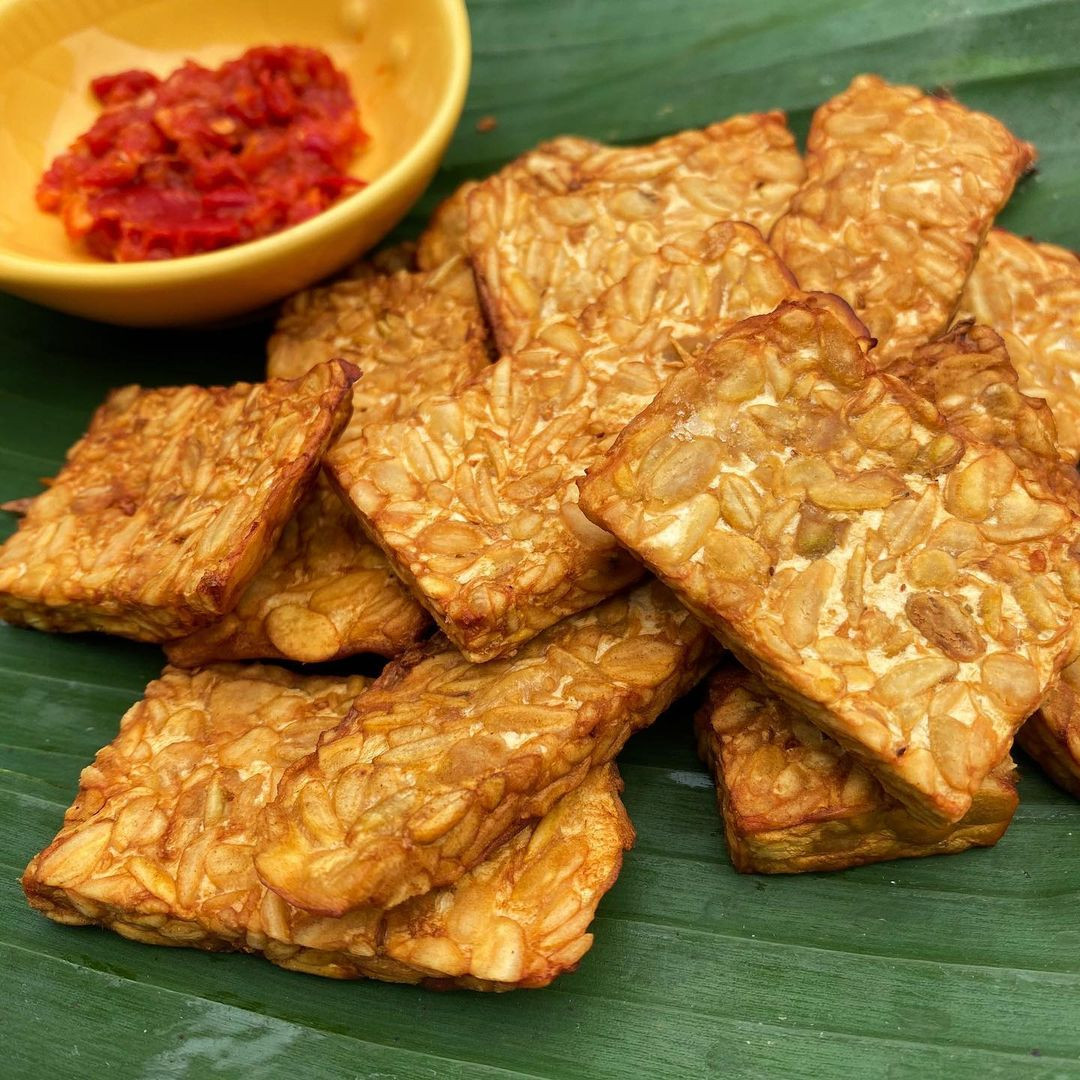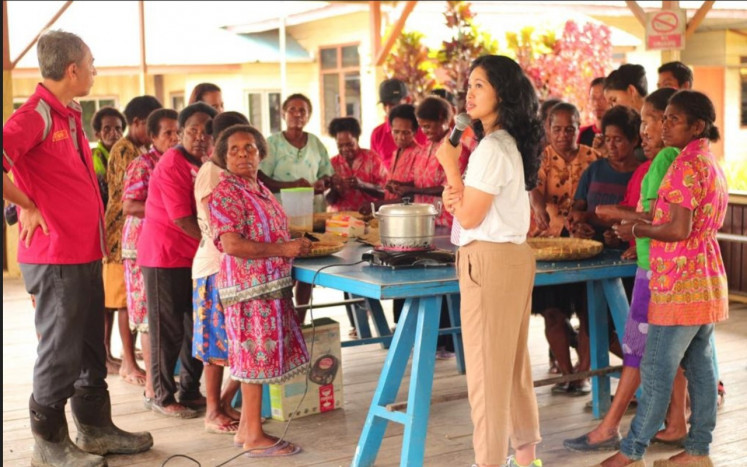Popular Reads
Top Results
Can't find what you're looking for?
View all search resultsPopular Reads
Top Results
Can't find what you're looking for?
View all search resultsIndonesian Icons: Tempeh the superfood and a link to Indonesia's past
"Indonesian Icons" is a new column providing an in-depth look at the public figures, as well as cultural staples and traditions that have defined the country. In this piece, we delve into the humble yet unbeatable dish that is the tempeh.
Change text size
Gift Premium Articles
to Anyone
T
empeh looms large as a time-honored celebrated staple in the everyday diet of many Indonesians, particularly people on Java Island, spurring Tourism and Creative Economy Minister Sandiaga Uno to register this fermented soy-based protein as a UNESCO Intangible Cultural Heritage. But there's more to its significance than taste. If anything, tempeh paves the way for one to see and learn about the country's past, traced to its humble origins and ultimately, meaning and identity.
Indonesia's first president, Sukarno, once mentioned tempeh in one of his provocative speeches not long after gaining Indonesia's independence.
"We are a nation of perseverance, not a nation of tempeh."
They were intended to be words of encouragement; however, this eventful occasion assigned and planted the meaning of tempeh in the mind of many Indonesians as a symbol of frailty and weakness.
Read also: Culinary groups promote Indonesian food
These days, the fate of tempeh is not substantially different. Tempeh is subject to the image of street food and second-class dishes because of its low price point. It has long been glossed over and taken for granted, rarely making an appearance in high-end restaurants. But three different generations of food scientist experts — Florentinus Gregorius Winarno, who is known as Indonesia’s father of food science and technology, Wida Winarno and Amadeus Driando Ahnan-Winarno — are changing the narrative to reclaim tempeh's former glory by presenting its history and true value further afield to the world.
Life-saving food
Driando was an ordinary biotechnology student with a bodybuilding obsession back in 2014. His limited monetary resources at that time urged him to find other less costly sources of protein. With his educational background and access to literacy, the result took him by surprise. An understated dish that he often found on his dining table, tempeh, turned out to be a high-digestibility protein source with 10 times less energy use and sold three times cheaper.
Time for tempeh: Tempeh is a fermented soy-based protein with a high nutritional profile, a celebrated staple that first emerged in Java and is now enjoyed all over the world. (JP/Courtesy of Driando Ahnan-Winarno)"When I told my peers, they were full of skepticism and disbelief. It's a big letdown that tempeh, with its extraordinary potential from a scientific viewpoint and sustainability promise, is impeded with a stigma," Driando, the cofounder of London-based tempeh start-up Better Nature told The Jakarta Post.
Driando's mother, Wida Winarno, and his grandfather, Winarno, share the same fascination with tempeh resulting in the 2015 International Youth Conference on Tempeh in Yogyakarta. There were about 300 attendants from seven countries filling the seats. The number was not spectacular, but the appeal of tempeh spoke for itself, carried forward by word of mouth.
The conference birthed the Indonesian Tempe Movement's Instagram account, @tempemovement, in 2015, with a mission to redefine tempeh's image and gift it from Indonesia to the world. Since then, the Winarnos have been offered a handful of collaboration opportunities from restaurants, prisons and rehabilitation centers both at home and abroad to introduce tempeh as food and as a means to continue living with dignity.
"There was this one time when I conducted a tempeh-making workshop for inmates at Cipinang penitentiary. Some healthy-looking men were sitting before me, but it felt like I was talking to flesh with no soul," Wida recalled of one of her workshops.
"But I carried on with the workshop, explaining what makes tempeh special and how to make it. Slowly but surely, their eyes started to beam with life. It was a very touching experience."
Read also: Beyond rice supremacy and food diversity in Indonesia
With tempeh, Wida has touched hearts, sparked hope and helped the lives of many. Once, Wida held a tempeh-making workshop in Indonesia's eastern region Ambon, the capital of Maluku. In the span of just an hour or two, Wida has helped people facing protein shortages.
Tempeh to the world: Wida Winarno leads a tempeh-making workshop in Sorong, Papua. (JP/Courtesy of Driando Ahnan-Winarno)"Ambon is an island surrounded by the sea, so my initial thought was there must be a lot of seafood at [residents’] disposal. Yet it turns out that when the west monsoon blows, the breadwinner won't be able to sail for a few months. So, when they can make tempeh on their own, they don't have to worry about what to eat tomorrow anymore," Wida said.
Versatile swap
Tempeh has been hailed as a superfood for its nutritional profile.
"Tempeh is mostly known as a plant-based protein source, but more than that, tempeh contains high amounts of fiber. It contains a good amount of prebiotics that feeds the probiotic bacteria to keep our gut healthy,” 25-year-old nutrition coach and barre instructor Michelle King told the Post. “[Tempeh] is also rich with vitamins and minerals [such as iron and calcium] with low amounts of fat and cholesterol. It is filling and satiating, too."
On top of its nutritional profile, tempeh is a good swap for plant-based eaters. Mira Rosana, a 38-year-old housewife who is a flexitarian, always resorts to tempeh for her protein intake. She also occasionally creates her tempeh from scratch for the sake of hygiene and fulfillment.
"Making my own tempeh is challenging but fun! Although it's somewhat easy to make tempeh from scratch, it requires patience. But it is very fulfilling to enjoy my creation of tempeh," said Mira, who turns tempeh into sate lilit Bali (Balinese minced meat satay) and sate maranggi (Purwakarta beef satay).
Michelle King agrees with Mira.
"I feel like tempeh is just beautiful as it is, unlike plant-based meat. I love adding tempeh to my meals, even the ones that do not usually use tempeh, because it absorbs flavor so well."
Her favorite tempeh pairings are sayur asem (vegetable tamarind soup), sambal terasi (shrimp chili paste) and fresh veggies served with warm rice.
The food of identity
The earliest reference of tempeh dates back to the 16th century in the Serat Centhini, a Javanese literary work of tales and teachings. Tempeh was mentioned in the manuscript as a dish of the said era, found around Mataram, Central Java. Accordingly, it is believed that tempeh has existed in Java since the 1600s, originally made from black soybeans. Today, other ingredients like green beans, red beans, peanuts, edamame and even instant noodles could serve as a base for tempeh creations.
Delicious workshop: Driando Ahnan-Winarno (behind the counter) conducts a tempeh-making workshop in the Consulate General of Indonesia in Chicago, the United States, in 2019. Driando founded the Indonesian Tempeh Movement, a non-profit organization that has expanded to the US as a 501(c)(3) organization. (JP/Courtesy of Driando Ahnan-Winarno)During those times, how people made their food was highly influenced by Chinese-style dishes whose main ingredients revolved around livestock like chickens, ducks and pigs, according to an article written by historian Ong Hok Ham.
Ownership of livestock requires large grassy fields, and it was a big challenge considering Java had always been densely populated. While having meat on the table was not really feasible at that time, tempeh had become the go-to meat replacement and had saved the nation from malnutrition and starvation.
Read also: Tempeh tipped to be Indonesia’s next big export to US as market for meat alternatives grows
Tempeh is like an ode to Indonesia's rich biodiversity and the pride of being Indonesians. Driando, who has been very passionate about promoting this one particular food to the world for six years and counting, told the Post that tempeh had helped him see Indonesia in a better way.
"Knowing tempeh is a humbling experience. Amid vast digitalization here and there, tempeh enables us to create food from scratch, mixing new substances to create healthier options. Tempeh is simple, affordable and has stood the test of time. It belongs to us only, and this kind of local culture can’t be bought nor replicated, no matter what," Driando said.














